|
Rarotonga, Niue, Tonga
Late October 2002
It
was a dark and stormy night.
Well, it
really was, a few times during our 1,400 miles of passages this past month,
which were quite a bit more boisterous than we’ve been used to. And we had a
few more things – major things – break than we’ve had before. All in all,
the three passages covered in this page took quite a bit out of us. But
still, there were gorgeous tropical islands to visit and more great people
to enjoy. So read on...
It’s getting late
We’ve become
known as the “Tail-Enders.”
That’s what
happens when you dawdle in beautiful French Polynesia, while most of your
cruising friends have long since sailed west to the other islands. It was
always our plan to stay as long as possible in the Tahiti area, but we did
start to feel a little lonely after Paul & Michelle left! But now we really
do have to keep moving to exit the area by the beginning of cyclone season
in December. Even cruisers have deadlines! From mid-September to
mid-October, we made three passages totaling 1,400 nautical miles in some
boisterous sea conditions. They weren’t exactly the Passages From Hell, but
as you’ll see we did have a few problems along the way. We are back to the
kind of wear and tear on the boat and our bodies that we faced on the
Marquesas passage.
 Happily our
New Zealand friends, Bjarne and Lise Elowsson, were with us from Bora Bora
to Tonga. I’m not sure they realized what lively passages we would have, but
they were real troopers and a big help throughout. All of the boats in our
fleet keep asking, “Where’s all the gentle trade wind sailing that we’ve
read about in all the cruising magazines?” We’ve had about three hours of
it, total, but otherwise it has been 20-25 knot winds and big confused seas.
I think the South Pacific Travel Bureau has been leading us on! Happily our
New Zealand friends, Bjarne and Lise Elowsson, were with us from Bora Bora
to Tonga. I’m not sure they realized what lively passages we would have, but
they were real troopers and a big help throughout. All of the boats in our
fleet keep asking, “Where’s all the gentle trade wind sailing that we’ve
read about in all the cruising magazines?” We’ve had about three hours of
it, total, but otherwise it has been 20-25 knot winds and big confused seas.
I think the South Pacific Travel Bureau has been leading us on!
Passage to Rarotonga
On leaving
the protected anchorage at Bora Bora on September 15th, right
away we had 10-foot beam (from the side) seas and 20 knot winds.
Uncomfortable and wet, but manageable. With a fair number of waves washing
over the deck, we began to notice water dripping down the mast in our cabin.
It seems the deck wedges that were keeping the mast from moving had come out
and the seal had separated. The mast was working back and forth about an
inch as we rolled in the waves, which is a bit scary to watch – “Will the
mast stay in the boat?” – but Raven is strongly built so we really weren’t
worried. Jan did an at-sea repair as best he could, and we continued to mop
up for the rest of the three-day passage.
Losing the reacher
On our
second day, with lighter winds we were flying our favorite sail, the big
reacher, and making good speed. It was a beautiful day for a sail until
suddenly there was a loud bang and the reacher – all 1,352 square feet of it
– dropped into the sea. The halyard had chafed through in a new place, not
previously reinforced by Mark the Rigger. A wet sail is a real bear to
handle, especially one that big, dragging in the water behind the boat.
There is always the worry that it will get caught in the propeller or go
under the boat. Luckily, it was daylight and Jan was at the helm, so he
slowed Raven down right away. All four of us were in harnesses, so we hooked
on and in a half hour – which seemed like four hours – we got it aboard and
no one was hurt. The sail was intact, but striped with black bottom paint,
so it was another messy job to stuff it all into the forepeak, while Raven
rolled mightily, to be dealt with later. Whew. We’re just sorry we don’t
have photos to show you the foredeck full of acres of white sail with black
stripes. Lise did her usual superb job of whipping up a gourmet lunch for
us, and we all recovered.
_small.JPG) A boat on a
passage is not a pretty sight. Everyone has his stash of personal stuff
close at hand – water bottles, packets of cookies, warm clothes, cool
clothes, harnesses and tethers, sunscreen, hats, glasses, pillows and
blankets for those few precious hours off watch. All of this junk stays out
so you can find it in the dark when you don’t want to wake anyone who has
finally managed to sleep despite the rocking and rolling, the noise of a
creaking mast and boom, the slap of waves against the hull, the sails
slamming if there is a wind change, and the occasional radio traffic. Our
guests usually do pretty well in their aft cabin where there is less motion,
but our forward cabin is often uncomfortable in the big South Pacific
swells, which means sleeping au sauvage on the settees in the main
salon. Doesn’t this make you want to rush right out and sign on for the next
passage? A boat on a
passage is not a pretty sight. Everyone has his stash of personal stuff
close at hand – water bottles, packets of cookies, warm clothes, cool
clothes, harnesses and tethers, sunscreen, hats, glasses, pillows and
blankets for those few precious hours off watch. All of this junk stays out
so you can find it in the dark when you don’t want to wake anyone who has
finally managed to sleep despite the rocking and rolling, the noise of a
creaking mast and boom, the slap of waves against the hull, the sails
slamming if there is a wind change, and the occasional radio traffic. Our
guests usually do pretty well in their aft cabin where there is less motion,
but our forward cabin is often uncomfortable in the big South Pacific
swells, which means sleeping au sauvage on the settees in the main
salon. Doesn’t this make you want to rush right out and sign on for the next
passage?
As you might
imagine, this wasn’t our favorite passage of all time, and Bjarne and Lise
had a tough start to their cruise aboard Raven. It wasn’t the wind that was
the problem – it never went over 25 knots – but the seas coming from two or
three different directions that made it bouncy.
Rarotonga
 Finally at 6
a.m. on September 19th we spotted the island of Rarotonga (not to
be confused with the Kingdom of Tonga, which will come later). Rarotonga is
in the Cook Islands, a protectorate of New Zealand. After five months of
speaking French and paying huge prices for everything, it was an amazing
treat to hear and speak English, and have what seemed like bargain prices.
Best of all, everyone was really friendly. Finally at 6
a.m. on September 19th we spotted the island of Rarotonga (not to
be confused with the Kingdom of Tonga, which will come later). Rarotonga is
in the Cook Islands, a protectorate of New Zealand. After five months of
speaking French and paying huge prices for everything, it was an amazing
treat to hear and speak English, and have what seemed like bargain prices.
Best of all, everyone was really friendly.
  The only
discouraging part of our arrival was that the tiny harbor, in a U-shape, was
one of the most uncomfortable we have seen. Sharing this little pocket with
the sailboats were big rusty cargo ships and fishboats. Along one side,
sailboats were moored Tahiti-style along a very dirty concrete quay with a
big surge. (A Tahiti- or Med-moor is when you drop your anchor and back into
a narrow spot between other boats and tie your stern lines to the quay.)
Several other boats were also anchored in the narrow harbor, and that’s
where we put Raven. The problem with being at anchor is that every time a
ship comes into the harbor, you must raise anchor, leave the harbor until
the ship docks, then go back in and anchor again. Did I mention that this
was a difficult harbor? The only
discouraging part of our arrival was that the tiny harbor, in a U-shape, was
one of the most uncomfortable we have seen. Sharing this little pocket with
the sailboats were big rusty cargo ships and fishboats. Along one side,
sailboats were moored Tahiti-style along a very dirty concrete quay with a
big surge. (A Tahiti- or Med-moor is when you drop your anchor and back into
a narrow spot between other boats and tie your stern lines to the quay.)
Several other boats were also anchored in the narrow harbor, and that’s
where we put Raven. The problem with being at anchor is that every time a
ship comes into the harbor, you must raise anchor, leave the harbor until
the ship docks, then go back in and anchor again. Did I mention that this
was a difficult harbor?
After a
couple of days, we had our chance at the quay. It was all very rolly and the
tight-packed boats created a macramé of fenders and lines going to neighbors
and to the quay. Getting ashore still wasn’t easy, either, as you had to use
your dinghy to get to a slippery ladder, and leap onto it in the three-foot
surge. Sturdy sandals and quick-dry clothes were essential. Fun! Ah, the
prices we pay for Paradise.
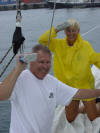 The weather
was rainy when we arrived, perfect for reacher cleaning. Bjarne and the two
of us spent a few hours in a downpour with that massive sail on deck, with
scrub brushes and soap in hand. Thank goodness we were all able to laugh
about it –“ wet t-shirt contests,” “Welcome to the Tropics,” “Are we having
fun yet?” etc. All the while, Lise cleaned passage mess out of Raven’s
interior, and kept us fed and warmed with food and hot drinks. We’re proud
to say we got 99% of the bottom paint off the sail, rinsed the salt out in
fresh rain water, and dried it on deck over the next few days, before
rolling it up and stowing it away until New Zealand. We miss the speed that
sail offers, but aren’t willing to risk damaging it. We must find a
permanent fix for that chafe problem when we get to New Zealand. The weather
was rainy when we arrived, perfect for reacher cleaning. Bjarne and the two
of us spent a few hours in a downpour with that massive sail on deck, with
scrub brushes and soap in hand. Thank goodness we were all able to laugh
about it –“ wet t-shirt contests,” “Welcome to the Tropics,” “Are we having
fun yet?” etc. All the while, Lise cleaned passage mess out of Raven’s
interior, and kept us fed and warmed with food and hot drinks. We’re proud
to say we got 99% of the bottom paint off the sail, rinsed the salt out in
fresh rain water, and dried it on deck over the next few days, before
rolling it up and stowing it away until New Zealand. We miss the speed that
sail offers, but aren’t willing to risk damaging it. We must find a
permanent fix for that chafe problem when we get to New Zealand.
Rarotonga is
thoroughly Polynesian and has the usual tribal-missionary-tourism history.
It has a close connection with New Zealand, uses kiwi dollars as currency,
and the locals speak English with a distinctly Auckland lilt. That’s
probably because more Cook Islanders live in Auckland than in the Cooks!
The island
is very rural and beautiful, with volcanic central peaks circled by an
ancient inland road that goes by fields of taro, tomatoes, bananas, and
papayas. A daily market right next to the harbor sold much of the produce of
these farms. We even got fresh herbs. The big market day, Saturday, saw the
arrival of many locals to socialize, have lunch, and buy flower crowns and
vegetables. It was really pleasant.
  We spent one
day at the cultural center, learning how to weave pandanus, harvest
coconuts, use plants in Rarotongan medicine, how to play the drums, and how
to dance. Jan was an expert at the latter skills. He vows to learn the
haka when we reach New Zealand. We spent one
day at the cultural center, learning how to weave pandanus, harvest
coconuts, use plants in Rarotongan medicine, how to play the drums, and how
to dance. Jan was an expert at the latter skills. He vows to learn the
haka when we reach New Zealand.
The big
surprise of the island was the number of very good restaurants. We had
expected good food in French Polynesia, which we never really found. It’s
got French influence, so the food must be good, right? Guess not. In out of
the way Rarotonga, there were good spots galore. Most of them had locations
looking out over the water, and the prices were a fraction of those in
Tahiti. It was a radically nice change from the pricey brand of tourism on
Bora Bora.
Niue
 After a
two-day wait for the winds to calm just a bit, we left Rarotonga at midday
on September 27th for our three day passage to Niue ("NOO-ay"), another tiny
Pacific island nation you’ve never heard of. It was an uneventful trip other
than more rolly seas and good winds. On the final day we had a Close
Encounter of the Ship Kind. We had just spotted Niue when we saw a fast
moving ship eighteen miles out on the radar, on a course converging with us,
so we took the safety measure of calling on the radio to make sure they saw
us. It was a container ship hustling to Auckland at 21 knots and would have
T-boned us if we hadn’t spoken up. You can never count on ships having
anyone paying attention to the radar, let alone watching for other boats. As
it was, the watch officer very politely changed course to avoid us, much to
our relief. After a
two-day wait for the winds to calm just a bit, we left Rarotonga at midday
on September 27th for our three day passage to Niue ("NOO-ay"), another tiny
Pacific island nation you’ve never heard of. It was an uneventful trip other
than more rolly seas and good winds. On the final day we had a Close
Encounter of the Ship Kind. We had just spotted Niue when we saw a fast
moving ship eighteen miles out on the radar, on a course converging with us,
so we took the safety measure of calling on the radio to make sure they saw
us. It was a container ship hustling to Auckland at 21 knots and would have
T-boned us if we hadn’t spoken up. You can never count on ships having
anyone paying attention to the radar, let alone watching for other boats. As
it was, the watch officer very politely changed course to avoid us, much to
our relief.
 We anchored
in Niue in what is known as an open roadstead. Basically, that means that
you are anchored on a 90-foot-deep coral shelf in the middle of the Pacific,
and if any weather systems come through, you make tracks to get the heck
out. The Niue Yacht Club has about 20 moorings (anchors with ropes and
little floats you can tie up to) they rent out for nominal sums. The club is
one in name only – no clubhouse or docks – but lots of friendly, helpful
members. We joined, got our official membership cards and T-shirts, and are
looking forward to receiving our annual newsletters! We anchored
in Niue in what is known as an open roadstead. Basically, that means that
you are anchored on a 90-foot-deep coral shelf in the middle of the Pacific,
and if any weather systems come through, you make tracks to get the heck
out. The Niue Yacht Club has about 20 moorings (anchors with ropes and
little floats you can tie up to) they rent out for nominal sums. The club is
one in name only – no clubhouse or docks – but lots of friendly, helpful
members. We joined, got our official membership cards and T-shirts, and are
looking forward to receiving our annual newsletters!
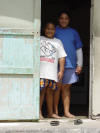 Niue is an
island untouched by tourism. In fact, the week we were there, the only
flight had been cancelled. People come there saying they’ll stay for a few
days and end up staying for weeks. It’s that kind of a place. We yachties,
as we are known in this part of the world, plus a few divers, are the only
tourists. We all stood out like sore thumbs, but were made to feel very
welcome everywhere from the cheery greeting of the harbormaster on the radio
(“Welcome to the Rock of the Pacific!”) to the smiling people in the shops. Niue is an
island untouched by tourism. In fact, the week we were there, the only
flight had been cancelled. People come there saying they’ll stay for a few
days and end up staying for weeks. It’s that kind of a place. We yachties,
as we are known in this part of the world, plus a few divers, are the only
tourists. We all stood out like sore thumbs, but were made to feel very
welcome everywhere from the cheery greeting of the harbormaster on the radio
(“Welcome to the Rock of the Pacific!”) to the smiling people in the shops.
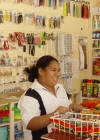 The locals
were very hopeful about a new flight that might bring in some tourism and
money to a very poor island. The population of 1,500 people is quickly
dropping as more and more people leave for New Zealand to find work. In
fact, almost ten times as many Niueans live in New Zealand as live on the
island itself. The island was full of abandoned houses and villages. The
main village, Alofi, consists of a bank, a laundry, a grocery store made up
of several shipping containers strung together, a church and a couple of
shops, half of them empty. That’s the capital. The locals
were very hopeful about a new flight that might bring in some tourism and
money to a very poor island. The population of 1,500 people is quickly
dropping as more and more people leave for New Zealand to find work. In
fact, almost ten times as many Niueans live in New Zealand as live on the
island itself. The island was full of abandoned houses and villages. The
main village, Alofi, consists of a bank, a laundry, a grocery store made up
of several shipping containers strung together, a church and a couple of
shops, half of them empty. That’s the capital.
 Going ashore
from this open roadstead was a real challenge. There was no place to dock or
even tie up a dinghy, but they have a well-honed system involving a big
electric crane. You snag your dinghy’s lifting harness onto the crane’s huge
hook, scramble up the step, then push the button to haul the dinghy up onto
the concrete quay. Then you park the dinghy until your return. Going ashore
from this open roadstead was a real challenge. There was no place to dock or
even tie up a dinghy, but they have a well-honed system involving a big
electric crane. You snag your dinghy’s lifting harness onto the crane’s huge
hook, scramble up the step, then push the button to haul the dinghy up onto
the concrete quay. Then you park the dinghy until your return.
  Niue is a
makatea, a coral atoll raised up long ago by geologic forces. Eons ago,
it was like the Tuamotu atolls, but then the whole island rose 50 or 100
feet out of the water. So now the island is riddled with ancient,
razor-sharp coral outcroppings and caves. We had some wonderful Niue is a
makatea, a coral atoll raised up long ago by geologic forces. Eons ago,
it was like the Tuamotu atolls, but then the whole island rose 50 or 100
feet out of the water. So now the island is riddled with ancient,
razor-sharp coral outcroppings and caves. We had some wonderful
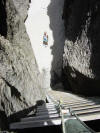 hikes and
sea hikes and
sea
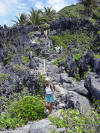 walks with very dramatic scenery. We walked on reefs in ankle deep water
where ladies were fishing for oysters and octopus. We went on woodsy walks
that led to sea arches and blowholes. We squeezed through several caves to
get to the crystal clear pools on the other side. The best adventure of all,
called Togo Chasm, took us through the woods into a landscape walks with very dramatic scenery. We walked on reefs in ankle deep water
where ladies were fishing for oysters and octopus. We went on woodsy walks
that led to sea arches and blowholes. We squeezed through several caves to
get to the crystal clear pools on the other side. The best adventure of all,
called Togo Chasm, took us through the woods into a landscape
 of
coral pinnacles, then down a steep ladder to a tiny of
coral pinnacles, then down a steep ladder to a tiny
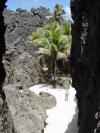 sandy-bottomed
canyon where storms had thrown coconuts, which sprouted and formed a little
glen inside high coral rock walls. The waves crash steadily through the
eroded rocks. sandy-bottomed
canyon where storms had thrown coconuts, which sprouted and formed a little
glen inside high coral rock walls. The waves crash steadily through the
eroded rocks.
On a search
for limes, we learned they were only available at the prison. Hmmm. Always
game for an adventure, Bjarne (who was used to driving on the wrong side of
the road, did a wonderful job as our driver in Niue and Rarotonga) drove the
four of us out there in our rented van. At the gate of the deserted-looking
little prison building Jan called out to see if there was anyone around. A
head peeked out between the bars of one cell, then a man opened the cell
door (!), picked up a large kitchen knife (!!), and walked over to us (!!!),
smiling and asking if we wanted some vegetables.
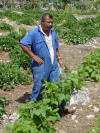 Simte, as we learned his
name was, definitely had our attention! Jan, feeling nervously chatty, asked
him if he was the warden. “No,” he said, ”I’m the prisoner.” We learned
later that he had murdered his mother-in-law (with a knife!!) and was
sentenced to eleven years. The other prisoner was the warden, who had killed
another prisoner. (Confused yet?) And neither one was locked in. Where would
they go on an island???? They just spent their days tending separate,
beautiful vegetable gardens and biding their time. Yes, Simte did sell us
some nice limes and string beans. Simte, as we learned his
name was, definitely had our attention! Jan, feeling nervously chatty, asked
him if he was the warden. “No,” he said, ”I’m the prisoner.” We learned
later that he had murdered his mother-in-law (with a knife!!) and was
sentenced to eleven years. The other prisoner was the warden, who had killed
another prisoner. (Confused yet?) And neither one was locked in. Where would
they go on an island???? They just spent their days tending separate,
beautiful vegetable gardens and biding their time. Yes, Simte did sell us
some nice limes and string beans.
The van
Bjarne drove so well, by the way, was infested with cockroaches. Welcome to
the tropical Third World. By now, we take this sort of thing in stride. No
sense complaining to the rental company – Avis it ain’t. An immediate stop
at the store produced a can of Raid; we sprayed most of it in the van,
sealed it up, and went to lunch. Every night we’d spray more Raid inside and
were greeted the next morning with a dozen critters with their legs up in
the air. No more roach problem.
  Niue
has some of the best diving in the world because of the water's
extraordinary clarity. The island has no streams and thus no silt to cloud
the 100'+ underwater views. One day, Jan made two dives with the excellent
local dive shop and loved swimming through underwater caves and seeing the
highly venomous sea snakes close up (allegedly, the snakes have mouths far
too small to bite a human. Ha!). There's just no accounting for taste,
is there? Niue
has some of the best diving in the world because of the water's
extraordinary clarity. The island has no streams and thus no silt to cloud
the 100'+ underwater views. One day, Jan made two dives with the excellent
local dive shop and loved swimming through underwater caves and seeing the
highly venomous sea snakes close up (allegedly, the snakes have mouths far
too small to bite a human. Ha!). There's just no accounting for taste,
is there?
In Niue, we
finally met up with Donal Botkin, with whom Jan had worked twenty years ago.
He had sailed across the Pacific to New Zealand and was on his way back to
California. We had been emailing each other and finally ended up in the same
anchorage. We had a good reunion with him and lots of other cruisers at a
barbecue given for the yachties by the Niue Yacht Club.
We didn’t
get to stay as long as we wanted in Niue because we got reports of some
serious weather coming through. There was no place to hide for weather
protection, so we decided to leave for Tonga while the leaving was good.
Tonga
The passage
was fast, 250 miles in only 28 hours, but it was one of our most boisterous.
For the first 12 hours, we averaged a blazing 10 knots in 20 to 25 knot
winds, with only the jib and reefed mainsail. It was exciting, but then the
winds got up to the high 20’s, and even 30 knots, and our speeds were going
higher.
Then it
happened. During the night, when we were hitting even faster speeds, there
was a load bang. Shades of the reacher going over the side on the way to
Rarotonga. We had broken the huge bolt that holds the hydraulic vang (a
critical item that keeps the boom from flying out of control) to the mast.
Jan and the long-suffering Bjarne had to wake up and go forward to rig a
temporary repair. They had to put all three reefs in the main – a first – to
take some of the pressure off of the vang. The two guys said they were
amazingly warm and comfortable during the half hour it took to get all this
done . . . until a big wave broke over them. That’s when Signe, still in the
pilothouse, saw the GPS speed indicator hit 14.1 knots, a new Raven record.
After that, they got that last reef in double-quick! Sleeping was very
marginal that night, but we still had a record passage.
 We were very
glad to turn the corner into the lee of Vava’u Island, Tonga. On the way
into Neiafu Harbor, we had a royal greeting from our friends on C’est La
Vie, Avventura, and North Road, who had been there for
about a month. They were in one of the many anchorages outside of town. We
had to go on into Neiafu to officially check in with customs and
immigration. Our friends on Final Straw had snagged a mooring for us, so we
didn’t have to risk anchoring while tired, in a deep and crowded harbor. It
pays to have friends who know the ropes. We were very
glad to turn the corner into the lee of Vava’u Island, Tonga. On the way
into Neiafu Harbor, we had a royal greeting from our friends on C’est La
Vie, Avventura, and North Road, who had been there for
about a month. They were in one of the many anchorages outside of town. We
had to go on into Neiafu to officially check in with customs and
immigration. Our friends on Final Straw had snagged a mooring for us, so we
didn’t have to risk anchoring while tired, in a deep and crowded harbor. It
pays to have friends who know the ropes.
  We were so
happy to see all our friends, and they were so glad to see the Big Boat,
that we had the first of several parties aboard Raven. The first night it
was a roast lamb dinner. The second night we had a cocktail party with a
sing-a-long. The third night a dozen of us had a championship game of
Cranium, which is probably the perfect cruiser game. We were so
happy to see all our friends, and they were so glad to see the Big Boat,
that we had the first of several parties aboard Raven. The first night it
was a roast lamb dinner. The second night we had a cocktail party with a
sing-a-long. The third night a dozen of us had a championship game of
Cranium, which is probably the perfect cruiser game.
  Sadly,
Bjarne and Lise had to leave us to fly back to Auckland. They said they had
to finish paving their driveway before we arrived to see their new house. We
left to explore the outer anchorages and meet up with even more friends. All
the anchorages go by numbers here according to the charts created by The
Moorings boat charter company. It sounds a little odd on the radio until you
learn the jargon: “We’re in #16 for the snorkeling today, but tomorrow we’ll
move to #10 for the Tongan feast.” Sadly,
Bjarne and Lise had to leave us to fly back to Auckland. They said they had
to finish paving their driveway before we arrived to see their new house. We
left to explore the outer anchorages and meet up with even more friends. All
the anchorages go by numbers here according to the charts created by The
Moorings boat charter company. It sounds a little odd on the radio until you
learn the jargon: “We’re in #16 for the snorkeling today, but tomorrow we’ll
move to #10 for the Tongan feast.”
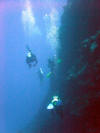 We moved
over to #13, Hunga, which is an ancient volcano that you can only
enter and exit at high tide, through a dramatic, narrow, and scary little
passage. It was quite a beautiful bay and very calm, even though the wind
was howling outside the caldera. C’est La Vie met a local fellow in a
dugout canoe who offered to take us around his village, which we did the
next day. We moved
over to #13, Hunga, which is an ancient volcano that you can only
enter and exit at high tide, through a dramatic, narrow, and scary little
passage. It was quite a beautiful bay and very calm, even though the wind
was howling outside the caldera. C’est La Vie met a local fellow in a
dugout canoe who offered to take us around his village, which we did the
next day.
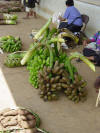 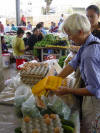 I’ve seen
lots of very Third World places on this adventure, but this was probably the
poorest village I’ve seen. They had also had some severe damage in the
January 2002 cyclone, so things were pretty sad. The houses were very
ramshackle, and the children were covered in sores, rags and dirt. Pigs,
chickens and dogs were running wild everywhere. But our guide, Vaka,
proudly showed us his “plantation” of papayas, bananas, taro, manioc and
kava. He has enough to support his family on what he can grow. I’ve seen
lots of very Third World places on this adventure, but this was probably the
poorest village I’ve seen. They had also had some severe damage in the
January 2002 cyclone, so things were pretty sad. The houses were very
ramshackle, and the children were covered in sores, rags and dirt. Pigs,
chickens and dogs were running wild everywhere. But our guide, Vaka,
proudly showed us his “plantation” of papayas, bananas, taro, manioc and
kava. He has enough to support his family on what he can grow.
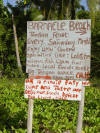 Typically for
a Tongan village of 200 people there are five Typically for
a Tongan village of 200 people there are five
 churches. It’s a very
conservative island group and strongly governed by church beliefs. Nothing,
absolutely nothing, is open on Sundays. You aren’t supposed to swim or work
on Sunday either. And they would really prefer that you dress conservatively
too. Both the women and men here, when dressed “properly,” wear long dark
skirts and long sleeves. In town both sexes also wear wraps of woven
basketry that cover their waists and hips. churches. It’s a very
conservative island group and strongly governed by church beliefs. Nothing,
absolutely nothing, is open on Sundays. You aren’t supposed to swim or work
on Sunday either. And they would really prefer that you dress conservatively
too. Both the women and men here, when dressed “properly,” wear long dark
skirts and long sleeves. In town both sexes also wear wraps of woven
basketry that cover their waists and hips.
  While in
Hunga, Jan had the watermaker running one day when it started smoking,
which is not a good thing for a big electric motor to do. Happily, a Kiwi
cruiser – a former boatbuilder – came over and displayed his amazing skills
with boat systems. In short order, he cleaned the motor brushes, had the
motor going again, and refused to take payment for his efforts. Jan gave him
some tools and profuse thanks for the lesson in how to resurrect electric
motors. The Cruising Community continues to amaze us with its generosity and
sharing of expertise. While in
Hunga, Jan had the watermaker running one day when it started smoking,
which is not a good thing for a big electric motor to do. Happily, a Kiwi
cruiser – a former boatbuilder – came over and displayed his amazing skills
with boat systems. In short order, he cleaned the motor brushes, had the
motor going again, and refused to take payment for his efforts. Jan gave him
some tools and profuse thanks for the lesson in how to resurrect electric
motors. The Cruising Community continues to amaze us with its generosity and
sharing of expertise.
Moving on again
  Many of our
friends are starting to disperse south to the Ha’apai group of islands, then
to Tongatapu, the capital island of Tonga, to prepare for the Big Leap to
New Zealand. No one is looking forward to that passage, so the gatherings
are filled with apprehensive talk about the best route, the weather, GPS
waypoints, radio networks, etc. It is all a bit unnerving and we are Many of our
friends are starting to disperse south to the Ha’apai group of islands, then
to Tongatapu, the capital island of Tonga, to prepare for the Big Leap to
New Zealand. No one is looking forward to that passage, so the gatherings
are filled with apprehensive talk about the best route, the weather, GPS
waypoints, radio networks, etc. It is all a bit unnerving and we are
 trying
to stay out of it as long as possible. Ken and Cathy of Felicity, who
did the same passage last year and have spent the year in Auckland, are
coming to Tongatapu on November 2nd to do the passage with us.
And we’re certainly looking forward to having them. trying
to stay out of it as long as possible. Ken and Cathy of Felicity, who
did the same passage last year and have spent the year in Auckland, are
coming to Tongatapu on November 2nd to do the passage with us.
And we’re certainly looking forward to having them.
So after
November 2nd, any spare prayers, good thoughts, angels, etc. will
be gratefully accepted.
Warm regards
from Signe & Jan
PS from
Signe: For those of you thought I was going to use the “747 method” to get
to New Zealand: I cut myself the same deal as the Marquesas passage: I’ll do
all the cooking if I don’t have to stand night watch. We all think we have
the best deal!
Previous log
Next log
This page was last
updated on
04/13/04. |